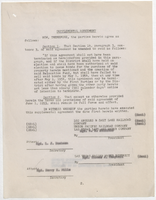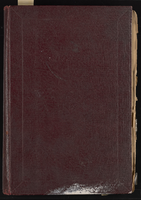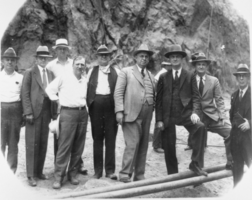Search the Special Collections and Archives Portal
Search Results

Supplemental agreement (blanks filled in) between Los Angeles & Salt Lake Railroad and partner companies and the Las Vegas Water District, C. L. D. No. 11342-1, 1954
Date
Archival Collection
Description
The purchase contract for the Las Vegas Land and Water Company allows for the contract to be annulled if its bonds are not sold by December 31, 1953. This contract rescinds that deadline, allowing as much time as needed for the sale of the bonds. Agreement that all parties will ignore the provision that any party can terminate the agreement if the bonds do not sell by May 1, 1954.
Text

"Nevada's First African American Wellness Conference Report"
Date
Archival Collection
Description
From the Alpha Kappa Alpha Sorority, Incorporated, Theta Theta Omega Chapter Records (MS-01014) -- Chapter records file.
Text

Map and basin profiles showing thickness of valley-fill deposits, Las Vegas Valley, Nevada, 1981
Date
Description
Image

Transcript of interview with Freddie Glusman by Barbara Tabach, October 29, 2015
Date
Archival Collection
Description
In this interview Glusman discusses his early memories of being raised in Vancouver, Canada and how he ended up in Las Vegas. He reflects on how he first got his start in the town and his early dealings with casinos and their owners while he was working as a carpet and drapery salesman and while working for Fabulous Magazine. Glusman explains how he started his restaurant and tells about the people he encountered while doing this that where significant to both the Jewish community and Las Vegas as a whole. He recounts stories that include such people as Meyer Lansky, Al Sachs, and Moe Dalitz.
Text

Transcript of interview with Gus Mancuso by Lisa Gioia-Acres, September 27, 2008
Date
Archival Collection
Description
Text

Bluebell Girls: scrapbook of newspaper clippings and photographs
Date
Archival Collection
Description
From the Margaret Kelly Collection on the Bluebell Girls, MS-00604. The scrapbook includes newspaper clippings about the Bluebell Girls, Folies-Bergère, and dancer Catherine Dunne's experiences in Milan, Italy at the start of World War II.
Mixed Content
Martinez, Jose Leonardo, 1971-
For Leonardo Martinez, the United States was never meant to be a destination—it was merely a short stop along the way as he awaited the day he could safely return to his family in El Salvador. Now a man who embraces the occasional Big Mac from McDonalds but never turns away a Salvadoran pupusa, Leonardo has embraced both places as home with memories that took him from his humble upbringings in Santa Lucía to the bright lights of the city of Las Vegas.
Person

Film transparency of businessmen, politicians, and engineers at Hoover Dam, June 6, 1933
Date
Archival Collection
Description
Image
Howard Booth Papers
Identifier
Abstract
The Howard Booth Papers are comprised of the personal papers of environmental activist Howard Booth from 1964 to 2017. The collection includes information about Booth's efforts to help turn Red Rock Canyon into a National Conservation Area. Booth was a member of multiple conservation organizations and the collection includes meeting minutes and newsletters from the Toiyabe chapter of the Sierra Club. The collection also contains correspondence, newspaper clippings, official reports, newsletters, and meeting minutes collected by Booth from various environmental organizations. The papers also include numerous photographic slides with handwritten captions Booth took of Red Rock and the surrounding area from the early 1980s to 2000s.
Archival Collection
Jack Kent Tillar Papers
Identifier
Abstract
The Jack Kent Tillar Papers (approximately 1890-2010) are comprised of magic-related books, periodicals, pamphlets, ephemera, and artifacts from the estate of Jack Kent Tillar who was a composer and music editor for the film and television industry. Materials also include a small amount of Tillar's personal papers. Tillar was an amateur mentalist magician and wrote numerous books and articles on the subject of telepathy and mentalism including
Archival Collection
